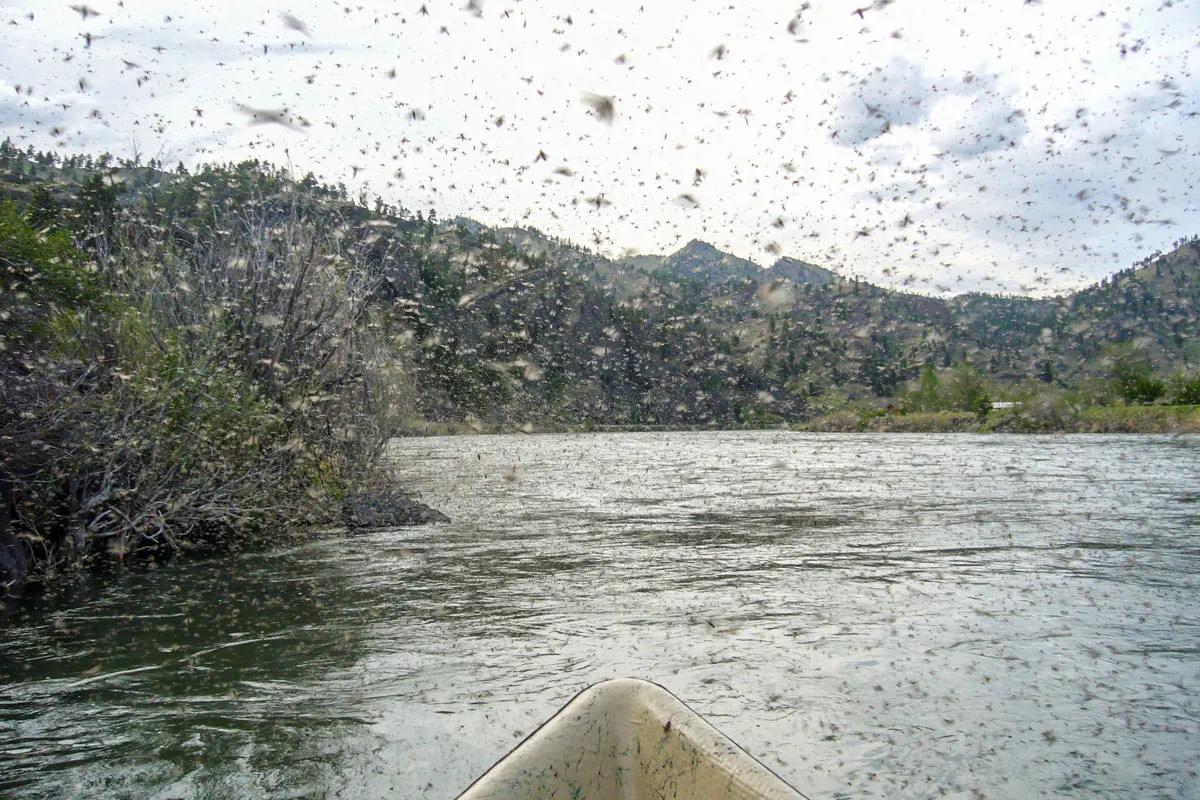
April is one of our favorite times to get out and fish our local waters. April provides excellent fishing, minimal crowds, and glimpses of good weather to come. Spring fishing is so wonderful that it pains me just a touch to share this information. The days of blistering cold have receded for the year leaving residents of the Big Sky state with a mixed bag. Sunny periods are punctuated by truncated squalls of snow and rain. Sun comes again and quickly dispels any snow that may have accumulated, usually within 24 hours. Daytime temperatures vary with sixty being a common sight. With increased temperatures and daylight hours the fish begin to feel the effects of the sun and this triggers consistent feeding. Hatches abound in the low clear water, and events for the dry fly angler can be numerous.
April fishing in Montana is largely characterized by a few events that produce the outstanding fishing. The first is a spawn, Rainbow trout spawn in the warming spring waters. Spawning events produce aggressive fish, aggressive fish are susceptible to fly angler trickery. The trout of Montana seek a very specific winter water type, and tend to pack in tight. Here they spend the majority of their winter in a hibernation like state. As the water temperatures warm, the fish maintain their winter residences but feed actively. High concentrations of feeding fish makes for stellar fishing. As the water temperatures continue to warm the fish being to disperse into the broad riffles with moderate pace.
April Hatches
Insect activity increases tenfold as March turns to April. April sees hatches of midges, stoneflies, mayflies, and caddis.

Midge hatches dominate the early part of the month providing dry fly action both in the mornings and afternoons. As water temperatures creep up beatis emerge and the trout experience the first mayfly event of the year. Cool, cast days force the long arduous process of wing drying and the trout respond accordingly. Tailouts provide the venue and great afternoon dry fly fishing can be had by all. March brown’s represent a lesser known mayfly hatch, but these large brown duns can entice nearly every fish in the river to feed with reckless abandon. The skwala stonefly nymph migrates toward the banks and the fish take notice eating stonefly imitations all spring long. The further west an angler travels the more consistent the stonefly hatch becomes. The Boulder and Madison rivers both host skwala populations that provide sporadic dry fly action. The end of the month often coincides with the first appearances of the Mother's Day caddis hatch, perhaps the most spectacular insect emergence in the west.
Virtually all of the fisheries in Southwest Montana can provide excellent fly fishing action. The fish have seen very few flies in the previous months and are as “dumb” as ever, spring creeks included.

The Madison River
The Madison River experiences a heavy spring run of rainbow trout that move out Ennis lake to spawn and gorge themselves. The fish that enter the river are from 16 to 22” and have some girth. Bright silver flanks beam upon setting the hook and an energetic fight ensues. A mere 30 minutes from our downtown shop puts an angler firmly on the Lower Madison. The spring time is the premier time to fish the lower Madison when it experiences strong hatches of baetis and eventually Mother's Day Caddis (caddis on the Lower Madison show up in May).
The Yellowstone
The Yellowstone River provides real opportunities for trophy browns and dry fly fishing. From the upper reaches near Gardiner to Columbus every stretch of river has a different offering. Early season streamer fishing can be quite productive with the lessened holding water. Depending on temperatures and the timing of runoff Paradise Valley harbors one of the premium locations to fish the Mother's Day caddis hatch. Even in dirty water fish will still line the soft edges to eat these plump caddis.
The Gallatin
The Gallatin River is a true local fishery and provides easy access to quality trout fishing from Bozeman or Big Sky. While the hatch activity isn't as heavy as some of the larger rivers, the wading is easy and the fish are amenable. From its confluence at Three Forks to the Yellowstone Park boundary, there is water that suits everyone's eye. The lower river provides longer “classic” runs. The canyon stretch provides the easiest access as it is largely national forest with endless pocket water and pull offs. As Big Sky looms, the river decreases in veracity and smaller stream fishing emerges.
Spring Creeks
The paradise valley spring creeks offer up some impressive spring fishing. Fish move in from the Yellowstone to spawn and they are active. Solid hatches of baetis and midges operate like clockwork most days, well thought out presentations and flies are often rewarded despite the creeks technical reputation. Because of the small rod fee (access fee) and a daily cap on anglers the creeks never feel crowded and are well worth the price of admission.

The Missouri
For those seeking numbers from the boat, consider the Missouri river. Epic fish populations and a lack of aquatic grass ensure the fish are readily accessible. The ample biomass and habitat grow rainbow and brown trout that average 16” to 22”. Hatches of both midges and baetis break up the productive nymph fishing.
Other Options
Anglers set on experiencing a skwala hatch should look west of the continental divide and consider the Clark Fork or the Bitterroot. These long flowing western streams teem with healthy populations of cutthroat, brown, and rainbow trout. Because of the population of cutthroat, even marginal hatches will have participating fish and some excellent dry fly opportunities.
